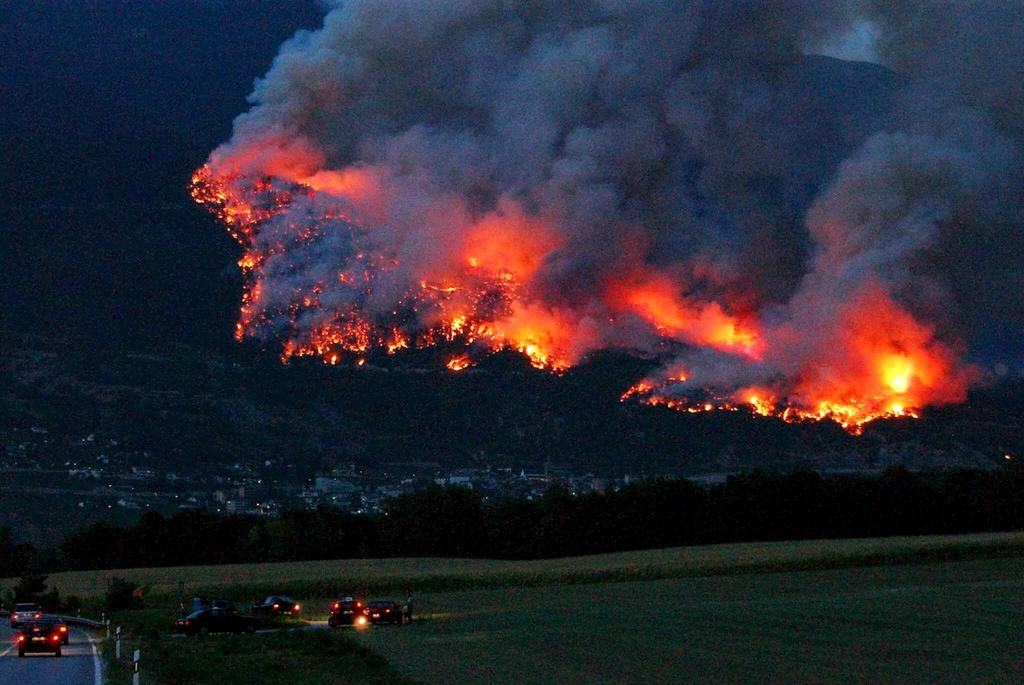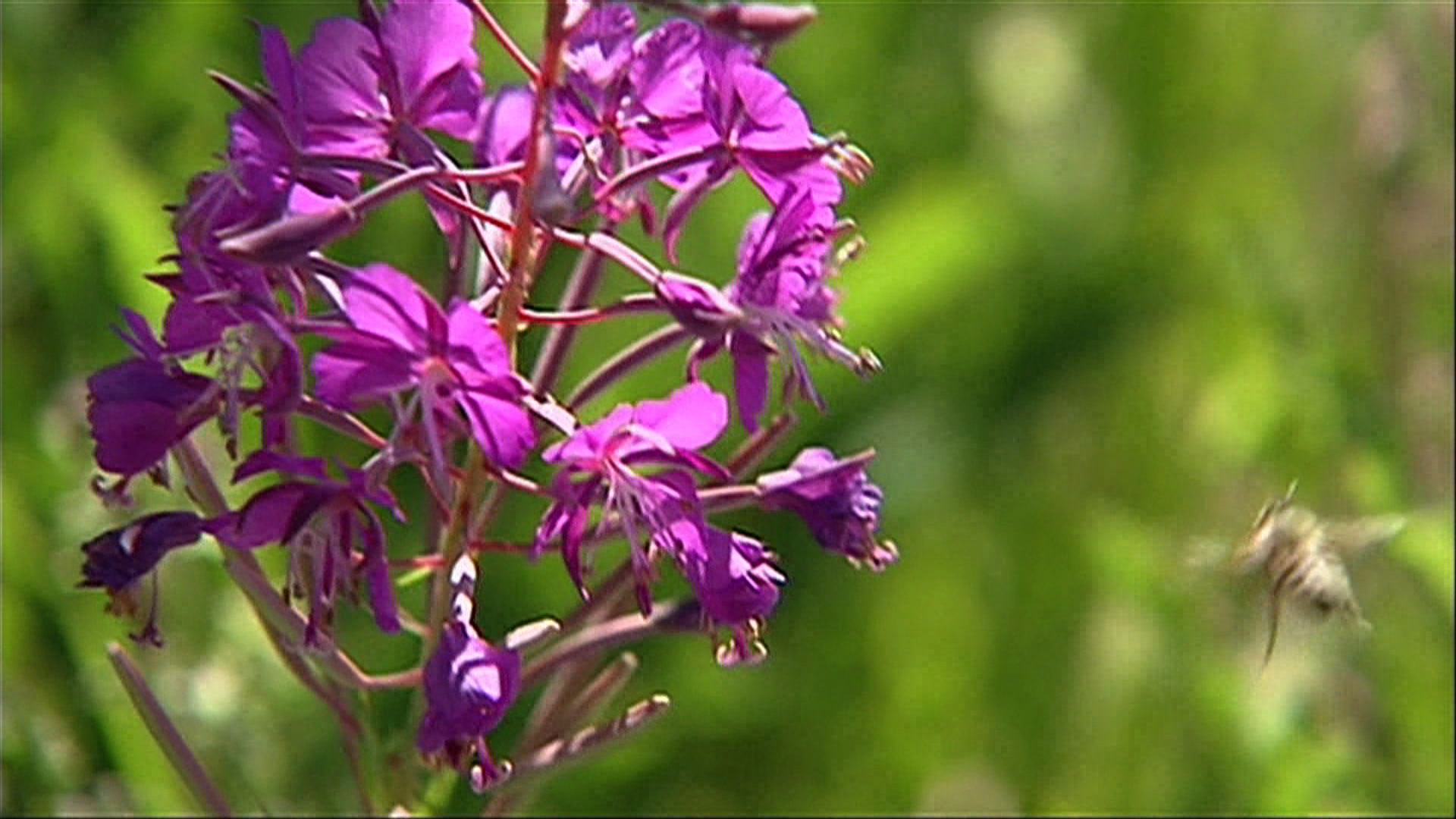From blackened hillside to colourful diversity

Charred tree stumps, huge black patches scarring the landscape – familiar sights in hot countries with plenty of forests, from Australia, to the Americas and to the Mediterranean. Recent fires in Switzerland have shown that prevention measures must be adapted to suit the nature of the forest.
This year, the Swiss have been recalling one of the country’s biggest forest fires in living memory: the 2003 fire above the village of Leuk in the southern canton of Valais.
Switzerland is a small country, which means that its forests are also tiny in international comparison. The Leuk fire destroyed “only” 300 hectares. But its very smallness means that the forests are often close to inhabited areas.
Leuk is not the only fire to have seared itself into the national consciousness. Just over two years ago, in April 2011, a fire on the opposite side of the Rhone valley, close to Visp, destroyed 100 hectares. And it’s been 30 years since the big fire in the Val Müstair, in the far south east of Switzerland.
Protective function
A major problem in Switzerland is that its hillside forests play a vital role in protecting infrastructure from avalanches and mud or rock slides. This means urgent measures are necessary straight away.
Exactly what steps are taken depends on the nature of the forest. In Visp about 95 per cent of what was lost had had a protective function. Although in Leuk a much wider area was destroyed, only a small part of it had played the same role.

More
Forest regrows after devastating fire
An immediate step to prevent soil erosion is cross-felling: the burnt trees are cut down, leaving short stumps against which the trunks are laid, and which hold them in place.
“In Leuk, cross-felling was really the only step that could be taken relatively quickly and at reasonable cost,” said Alban Brigger, of the Upper Valais Forest and Landscape Office. “We then did the same thing in Visp, and it has proved very effective. But we also had to put up protective netting and so on.”
Another option is planting saplings. Canton Valais – the site of the Leuk and Visp fires – tends not to favour this. It was done sparingly, and only to speed up regeneration.
In the Val Müstair, saplings were planted before cross-felling was done; the old trees were then laid across them, in order to protect them from deer, which are well-known for browsing – and destroying – young trees. The particular location of the forest – between the Swiss and the South Tyrol National Parks – means that it is a corridor for animals going from one to the other.
But while replanting is considerably cheaper than building nets and other artificial protection, it is not cheap – and the saplings require care, particularly water. In the Val Müstair watering continued for five years, although only in the dry periods. Even so, watering cost about the same as the original planting, Hansjörg Weber of the Graubünden Office of Forests and Natural Hazards told swissinfo.ch.
In every case the costs of the procedure have to be weighed against the benefits.
“We really didn’t want to take any risks,” said Weber. “I would do the same again.”
Natural regeneration
Eventually – after many decades, or even a century – the forests will fully regenerate of their own accord, although their composition will change, since different tree species react differently to fire.
The oaks on the lower slopes of the Leuk fire burnt right down, but within five years the stumps had resprouted, which does not happen with Scots pine[pinus silvestris], for example.
“The more fires we have, the more oaks can resprout, and the more pines will die,” explained Thomas Wohlgemuth, head of the Disturbance Ecology research group at the Swiss Federal Institute for Forest, Snow and Landscape Research (WSL).
In the aftermath of the fire in Val Müstair, a number of deciduous trees appeared spontaneously where they had not been before, Weber said. They included aspen, willows, birch and red elder, which grew down in the valley and whose light wind-borne seeds took root where the old forest had burned down.
“Of course that’s a very good thing, because they are pioneer trees which help to stabilise the soil.” They had an additional advantage for that particular forest: the deer prefer deciduous trees – which meant they left the young conifers alone.
About one third of Switzerland is covered in forest, and about half of these forests have a protection function, protecting people and infrastructure from natural hazards such as avalanches, rock falls, landslides and mud torrents.
Most of the protective forests are in the mountainous areas.
In the period 2008 – 2011, the federal government invested CHF250 million ($267 million) annually in protection against natural hazards: 24% of this went to the maintenance and improvement of the protective function of forests.
The cantons are responsible for ensuring basic forest management.
The Federal Environment Office publishes an up-to-date list of the fire risk canton by canton on its website, and information about the relevant measures taken by each canton.
The cantons are responsible for the warnings issued and for fighting any fires.
The office supports technical facilities for combating fires, such as the installation of reservoirs for fire-fighting and of hydrants.
In conjunction with the Swiss Federal Institute for Forest, Snow and Landscape Research (WSL) it works out strategies to deal with the dangers of forest fires.
The WSL collects data on forest fires to help develop these strategies.
Source: Federal Environment Office
Prevention lessons learned
The vast majority of forest fires – at least 80 per cent, said Wohlgemuth – are caused by human beings, usually by carelessness, sometimes by arson. And as summers become warmer and drier as the climate changes, the risk of fires increases.
“But we know this, so prevention measures have been stepped up,” Wohlgemuth said. “This has happened since the fire in Leuk. In the last ten years we have had a decrease in the area burned down by forest fires. We don’t know if this is by chance, or if it is the first result of better prevention measures.”
Measures taken include wider availability of water and the construction of tracks through the forest to provide access for firefighting vehicles, and better training and equipment for the firefighters. But they also include improved warning systems, and raising public awareness.
“We’ve built extinguisher facilities specially for helicopters, so that they can get water very quickly,” said Weber. “We didn’t have that in 1983.” As for the cost – it’s just a few thousand francs to call in helicopters to put out a fire when it starts, and would go into millions to repair the damage if the forest burned.
The local people are also more aware, and have no hesitation about picking up the phone to let the forestry service know if they notice suspicious smoke, he said.
Distress
The sight of a burned landscape leaves few people indifferent, even specialists.
“The first time I went to the [Visp] forest, I was very strongly affected,” Brigger told swissinfo.ch. “I still remember clearly the acrid smell of all the burned trees. Initially you are under such pressure that for two or three weeks you are working almost day and night and you can’t digest it. Later I would wake up in the night and the smell of these trees would be in my nostrils. But with time you can distance yourself from it.”
Thirty years on, Weber recalls how the fire in Val Müstair burned for three weeks: people were frightened because they didn’t know when it would stop.
Afterwards his service organised a number of public tours for the locals, to show them what was being done. “It was an important part of our work to keep the public informed.”
Wohlgemuth is well aware that people always wonder how long the damage will last, but he takes a positive view.
“I can say it will only last for one or two years, and after that there is a kind of healing process. After the Leuk fire there was incredible regeneration, an increase in biodiversity at different levels, for the plants, for the insects, for the birds. It’s a very colourful phenomenon, and very interesting,” he said.
In the last 20 years there have been on average 90 forest fires per year, which have destroyed 374 ha.
It is often not possible to determine the cause of forest fires, but human activity is thought to be responsible for about 90%, of which about 12% are cases of arson. Lightning is responsble for around 10%.
Human carelessness includes: failure to extinguish picnic fires properly; discarded cigarettes; forestry and agricultural activities (e.g. straw burning, sparks from machinery); sparks from overhead power lines touching each other in unusually high winds; army firing practice.
In Switzerland most forest fires occur south of the Alps, in cantons Ticino and Graubünden.
These areas accumulate a lot of biomass in the summer – including chestnut litter, which is particularly combustible; they have low precipitation in winter, leaving the forest floor dry, and fires typically occur in late winter and early spring.
There are usually 10-15 fires every year in the central Alpine valleys, in particular in canton Valais. These occur mainly in the summer, when the warm temperatures dry out the pine forests.
In the last 30 years the risk of forest fires north of the Alps has increased as a result of prolonged dry periods with high temperatures.
Source: Federal Environment Office and WSL

In compliance with the JTI standards
More: SWI swissinfo.ch certified by the Journalism Trust Initiative
You can find an overview of ongoing debates with our journalists here. Please join us!
If you want to start a conversation about a topic raised in this article or want to report factual errors, email us at english@swissinfo.ch.